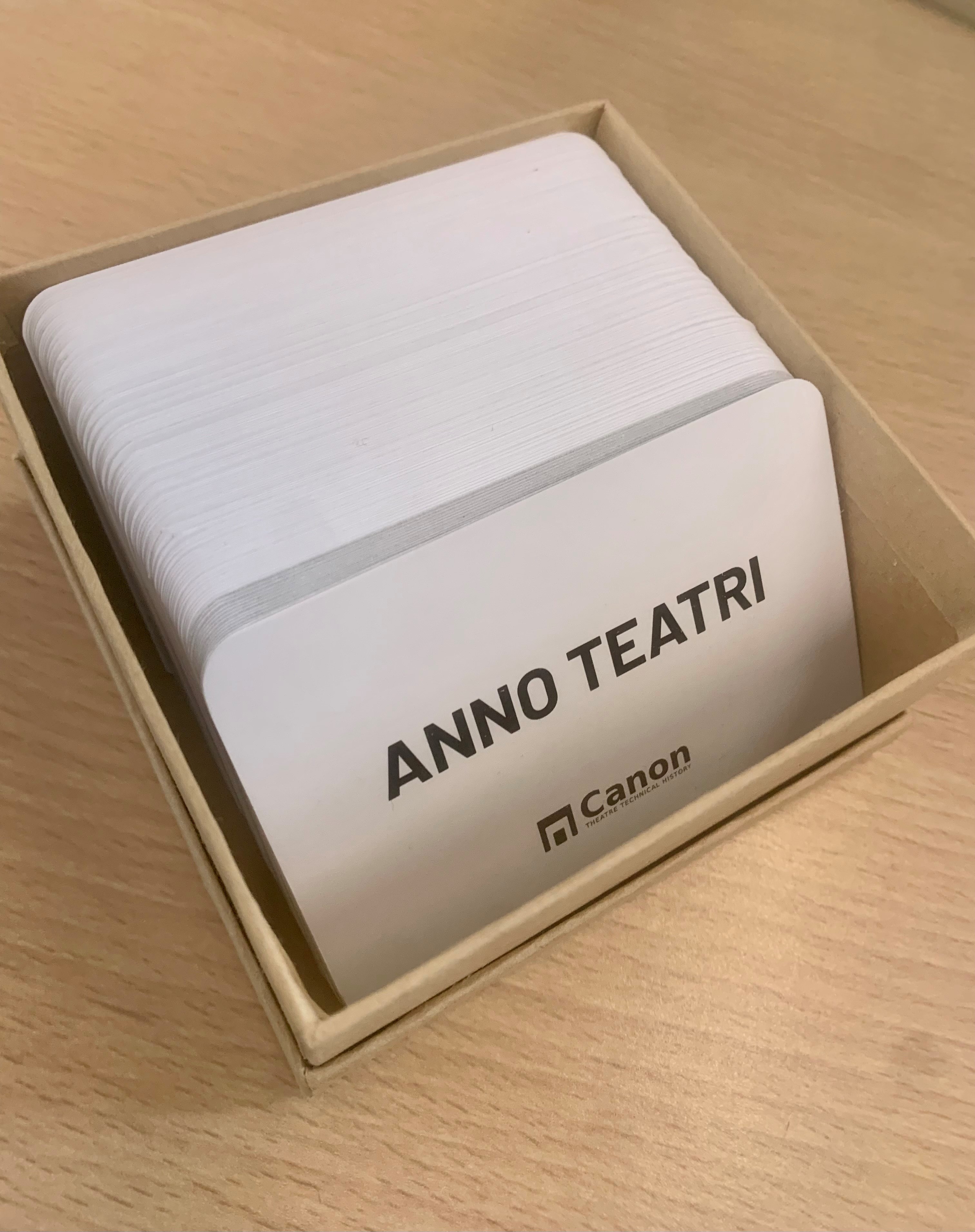The Card Game are a set of cards that collects key topics in relation of the History of the Technology in Theatre from different historical periods and from different countries. In the means of a card game the students play and therefore achieve a better understanding of the History of Theatre.
- For more information about using Anno Teatri as a teaching tool, see the related Canon Methodology.
- The rules of the game are below, or available as a PDF File:Anno Teatri - Rules of the game.pdf
- The artwork for the cards, so you can get your own copy printed, is available as a PDF File:Anno Teatri CANON final 221213.pdf
- The artwork is also available formatted to print on A4, so you can print the pages back-to-back, on thin card, and cut out, File:Anno Teatri CANON final 221213-printathome.pdf
Contents
Content[edit]
In this box you will find about 130 cards. On the front of each card, with the CANON Logo, there is an event from the history of technical theatre - the introduction of a technology, the opening of a building, or the birth of a person. On the back of the card is the year, decade or century of the event, together with a short description.
Playing[edit]
Who plays ANNO TEATRI?[edit]
The game is suitable for 2-10 players; the ideal number is 3 to 6. For large groups, you can speed up the game by dealing each player fewer than 9 cards at the beginning.
Categories & Levels[edit]
The cards have categories shown on them:
The cards also have 3 difficulty levels:
Use the categories and difficulty levels to customise the game, for example playing only with the cards about lighting, or only with Level 1 cards.
Getting started[edit]
Shuffle the cards and deal 9 to each player, with the Canon logo facing upwards. Players place their cards in front of them, without looking at the reverse side. Place the remaining cards in a pile in the middle, Canon logo upwards.
Important[edit]
Always keep the cards on the table during the game! Slide the cards when you move them, don't wave them around in the air - otherwise your fellow players will unintentionally find out the dates and information that you would be better off keeping secret.
How to play[edit]
The aim is to build a sequence. Place the top card from the deck in the centre, reading out the title but keeping the date and description secret. The first player begins by choosing one of their cards, reading the title out loud and placing it above the first card if they think their event occurred before the first event or below the it if they think their event occurred after.
Continuing play[edit]
Play continues around the other players. When it is their turn, a player can: Add one of their cards to the chain of events. They may insert their card anywhere in the chain, between cards that have already been laid out, or at either end, depending on where they think their event fits in the time sequence. Or If the player thinks there is an error in the time sequence, they may correct the sequence by rearranging the existing cards before adding their new card. Or Doubt the sequence.
Doubting[edit]
A player may choose not to add another card and instead publicly doubt the timing of the events. This ends the game round, and all the cards are turned over. If the chronological sequence is correct, the doubter takes four new cards from the deck. If there is any error in the sequence, the player who last put down an event takes two new cards from the deck. Even if it is only by a single year, and regardless of who laid the chronologically incorrect card, the previous player must take responsibility.
A new round[edit]
A new round begins with a new starting card from the deck - do not re-use the cards from the previous round. Play begins with the player who was the doubter in the previous round. Then it's pretty much round and round again.
Special cases[edit]
If the player starting a new round only has one card left, they must take two cards from the pile instead of one, arrange them and insert his last card.
The direction of play is reversed immediately and once as soon as a player only has two cards left.
The Winner[edit]
The winner is the player who is the first to play their last card - in a correct sequence, of course. The next player will certainly express doubts. If an error in the sequence comes to light, the player who played their last card takes two new cards, and the game continues.
Details[edit]
Century: a century lasts from the year 01 to the year 00 - for example, the 20th century began in 1901 and ends with the year 2000.
Around: around means that the event cannot be fixed exactly in time. Allow 5 years either side of the date - for example, if the card says 'Around 1900', the years 1895 to 1905 are considered correct. Simultaneous and overlapping events can be in any order.
Credits & Contact[edit]
The Game ANNO TEATRI is based on the original game ANNO DOMINI by Urs Hostettler, Fata Morgana and Abacus Spiele. ANNO TEATRI is a 'work in progress', so please contact us with corrections or ideas for new events: info@canon-timeline.eu.
The game is part of the Erasmus+ project 'CANON', researched and tested by the CANON team of teachers and students from 9 universities in 7 European countries. The idea and realisation of Anno Teatri is lead by Franziska Ritter.


